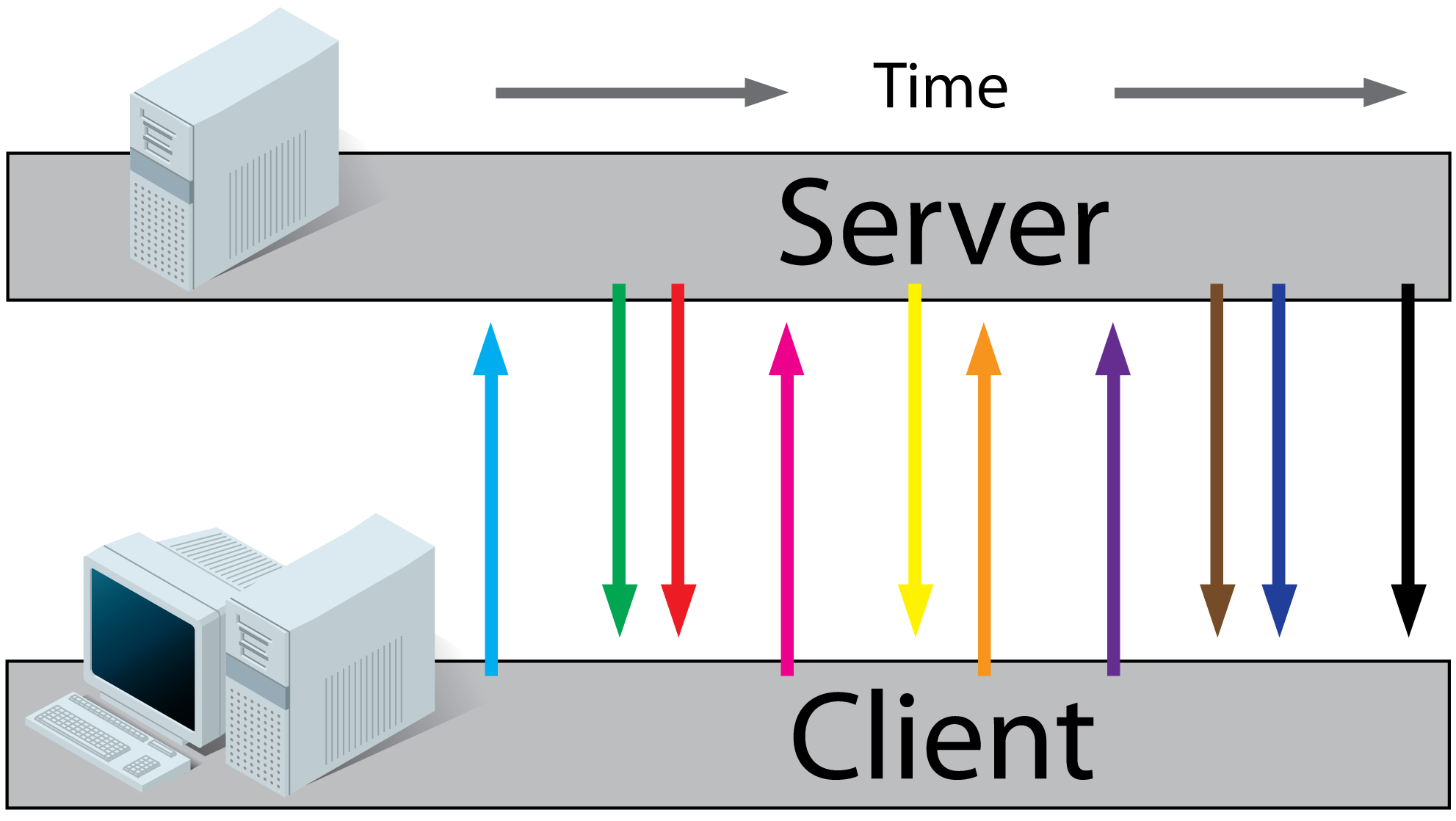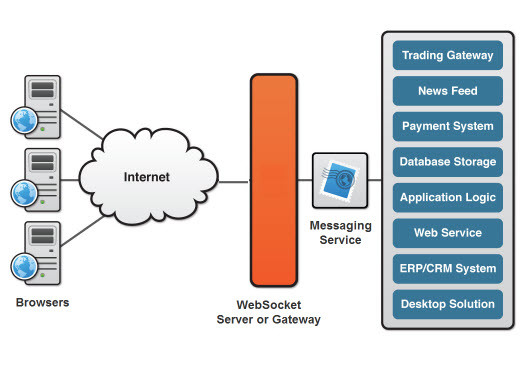WebSockets
Methods for Real-Time Data Streaming
WebSocket
- Protocol
- allows for a persistent, full-duplex communication between a client and remote host.
- HTML5
- defines a JavaScript API for the WebSocket protocol within the browser, allowing bi-directional communication between the browser and server.
Why?
Web apps need to communicate with the server in real-time
- HTTP based on request/response cycle
- Had no way to keep connections open until v1.1 (keep-alive)
- Lots of overhead in request handshake, error checking, and delivery validation
Can't we already do that?
...sort of
Full credit for the following diagrams goes to Tieme from his post on StackOverflow
AJAX Polling
Client sends AJAX request to server, server responds

AJAX Polling
Works when:
- client needs to request data occasionally
- client needs to send data occasionally
Falls short when:
- client needs to send data often
- server needs to iniate and send data without client request
AJAX Long-polling
Client sends AJAX request to server, server keeps request open until response available
Client immediately sends another long-poll request after receiving response

(also see Comet)
AJAX Long-polling
Works when:
- client needs to request one or a few pieces of data at a time
- server needs to send one or a few pieces of data occastionally
Falls short when:
- client needs to send data often
- client needs initiate and send data when available
- server needs to send data often
Server-Sent Events (SSE)
Client opens connection with server
Server sends data to client as it becomes available

Server-Sent Events (SSE)
Works when:
- server needs to send data often
- browser support for WebSockets can't be relied upon
Falls short when:
- client needs to send any data
WebSockets
Client opens connection with server
Client and server send data to each other as data becomes available on either side

WebSockets
Works when:
- server and/or client need to send data often
- browser support for WebSockets can be relied upon or fallbacks can be used
Falls short when:
- fallbacks can't be relied upon
Important components of the WebSocket spec
HTTP handshake
- Initial handshake via HTTP
- → upgrade to WebSocket connection
Request
GET /mychat HTTP/1.1
Host: server.example.com
Upgrade: websocket
Connection: Upgrade
Sec-WebSocket-Key: x3JJHMbDL1EzLkh9GBhXDw==
Sec-WebSocket-Protocol: chat
Sec-WebSocket-Version: 13
Origin: http://example.com
Response
HTTP/1.1 101 Switching Protocols
Upgrade: websocket
Connection: Upgrade
Sec-WebSocket-Accept: HSmrc0sMlYUkAGmm5OPpG2HaGWk=
Sec-WebSocket-Protocol: chat
*WebSocket protocol handshake via Wikipedia.
Full-duplex over TCP
Allows bi-directional communication over standard HTTP ports
(great for existing servers, proxies, and firewalls, which open 80 & 443)
URI structure
Defines new protocols, ws:// and wss:// for standard and secure WebSocket connections
Rest of WebSockets URI follows standard URI scheme
var connection = new WebSocket('ws://subdomain.examnple.com/some-endpoint')
WebSocket events
connection.onopen = function(e) {
console.log("Connected");
};
connection.onmessage = function(e) {
console.log( "Received: " + e.data);
};
connection.onclose = function(e) {
console.log("Connection closed");
};
Cross-domain
WebSockets is cross-domain by default
Up to you to optionally restrict domain access on server via Origin header
Request
GET ws://echo.websocket.org/?encoding=text HTTP/1.1
Origin: http://websocket.org
Cookie: __utma=99as
Connection: Upgrade
Host: echo.websocket.org
Sec-WebSocket-Key: uRovscZjNol/umbTt5uKmw==
Upgrade: websocket
Sec-WebSocket-Version: 13
Response
HTTP/1.1 101 WebSocket Protocol Handshake
Date: Fri, 10 Feb 2012 17:38:18 GMT
Connection: Upgrade
Server: Kaazing Gateway
Upgrade: WebSocket
Access-Control-Allow-Origin: http://websocket.org
Access-Control-Allow-Credentials: true
Sec-WebSocket-Accept: rLHCkw/SKsO9GAH/ZSFhBATDKrU=
Access-Control-Allow-Headers: content-type
*WebSocket protocol handshake via websocket.org.
Extensibility
Built-in method for defining WebSocket extensions via RFC
Current extensions include perframe-deflate and multiplexing
Optional subprotocol
var connection = new WebSocket('ws://html5rocks.websocket.org/echo', ['soap', 'xmpp']);
(See currently defined subprotocols)
Message data types
Original WebSocket spec allowed for strings
Now also allows buffered arrays and blobs
Sending String
connection.send('your message');
Sending ArrayBuffer
var img = canvas_context.getImageData(0, 0, 400, 320);
var binary = new Uint8Array(img.data.length);
for (var i = 0; i < img.data.length; i++) {
binary[i] = img.data[i];
}
connection.send(binary.buffer);
Sending Blob
var file = document.querySelector('input[type="file"]').files[0];
connection.send(file);
In the real world
(brain-dump)
Typical WebSocket architecture

Sending JSON
Doesn't support sending/receiving JSON (yet)
Can be accomplished by serializing/deserializing
Server
var WebSocketServer = require('ws').Server,
wss = new WebSocketServer({port: 8080});
wss.on('connection', function(ws) {
ws.send(JSON.stringify({
attribute: 'connected'
}));
});
Client
connection.onmessage = function (e) {
var response = JSON.parse(e.data);
};
Browser-to-server
Not really meant for server-to-server communication; better off using UDP or some other low-overhead transfer protocol if you control both servers
Not meant for browser-to-browser communication; that's what WebRTC is for
Proxies
Using ws in production can cause WebSockets communication to fail due to invisible proxies that can't do WebSockets
Using wss forces browser to issue HTTP_CONNECT statement to proxy server, which sets up tunnel
So use wss in production
Server must support WebSocket
Initial HTTP handshake to server requests WebSocket upgrade
Server upgrades connection if it knows how
Support can be added to most servers (modules exist for Nginx, Apache, etc.)
Back-end app must support WebSocket
Server can be built in any language, which supports event loop
Libraries exist for many languages, including Node, Ruby, Python, PHP, etc. (see list of libraries via Wikipedia)
Browser must support WebSocket
All modern browsers (including IE10 support WebSockets)
Except Android Browser (but supported in Mobile Chrome, avail on Android >= 4.0, default on Android >= 4.2)
Socket.IO is awesome
Server and client-side implementation (for Node on server side)
Abstracts WebSocket communications to automatically fall back to flash streaming or long-polling when necessary (on either server or client)
Adds features like heartbeats, timeouts, and disconnection support not provided in WebSocket API
Example real-world uses
- real-time chat application
- multi-player HTML5 game
- event-based in-page analytics
- more things
Build a basic WebSocket demo
Explore a cooler demo
Resources
- The WebSocket Protocol IETF draft
- About WebSockets via websocket.org
- WebSocket via Wikipedia
- Hypertext Transfer Protocol (HTTP) via Wikipedia
- Transmission Control Protocol (TCP) via Wikipedia
- Introduction to WebSockets: Bringing Sockets to the Web via html5rocks.com
- WebSocket Per-frame DEFLATE Extension via ietf.org
- WebSocket Multiplexing Extension via ietf.org
- Stream Updates with Server-Sent Events via html5rocks.com
- Comet via Wikipedia
- Differences between long-polling, WebSockets, Server-Sent events, and Comet via stackoverflow.com
- WebSocket Protocol Registries
- Socket.IO
- More demos via websocket.org
- SEM.js WebSockets event (this event)
- WebSockets Demo (for this presentation)